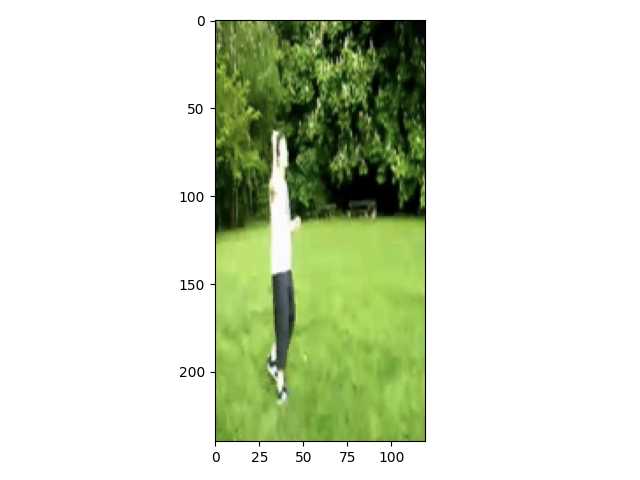mxnet decord 视频读取和载入
2021-02-09 08:15
标签:sys ram shuffle image numpy this which 桥接 hsi 控制帧的尺寸: 随机访问显然很慢,但decord使用内部优化来确保不会在这里浪费太多精力。 很容易一起获得许多帧: 可视化: 可以看到这个是从第一个视频截取、然后第二个...那么可以按照如下进行shuffle: 可以看到已经不是按照视频顺序截取了。 mxnet decord 视频读取和载入 标签:sys ram shuffle image numpy this which 桥接 hsi 原文地址:https://www.cnblogs.com/king-lps/p/13062801.htmlDecord Video Reader Example
import decord as de
from matplotlib import pyplot as plt
# using cpu in this example
ctx = de.cpu(0)
# example video
video = ‘Javelin_standing_throw_drill.mkv‘
vr = de.VideoReader(video) # using default resolution
print(‘Video frames #:‘, len(vr)) # 视频帧数
print(‘First frame shape:‘, vr[0].shape) # 每帧的shape
Video frames #: 48
First frame shape: (240, 320, 3)
vr = de.VideoReader(video, width=120, height=240)
print(‘Frame shape:‘, vr[0].shape)
Frame shape: (240, 120, 3)
返回的帧是DLPack兼容的NDArray格式(例如在TVM中使用),可转为numpy数组。
decord中有一个桥接系统,它自动将所有输出转换为与深度学习框架兼容的阵列,例如MXNet、PyTorch、Tensorflow。但始终可以利用numpy数组。frame10 = vr[10].asnumpy()
plt.imshow(frame10)
plt.show()

frames = vr.get_batch(range(0, len(vr) - 1, 5))
print(frames.shape)
(10, 240, 120, 3)
Decord Video Loader Example
import sys, os
import decord as de
# using cpu in this example
ctx = de.cpu(0)
# using batchsize = 2 and smaller resolution in this example
shape = (2, 480, 640, 3)
# using kinetics example videos
videos = [‘Javelin_standing_throw_drill.mkv‘, ‘flipping_a_pancake.mkv‘]
# using in-batch frame interval 5
interval = 5 # 一个batch中每两帧的距离
# using inter-batch frame interval 20, which means batch-batch interval is 20
skip = 3 # 不同batch之间的距离
# first see how sequential read looks like
vl = de.VideoLoader(videos, ctx=ctx, shape=shape, interval=interval, skip=skip, shuffle=0)
print(‘num batches:‘, len(vl))
num batches: 9
def disp_batches(video_loader, max_disp=5):
%matplotlib inline
from matplotlib import pyplot as plt
import matplotlib.gridspec as gridspec
cnt = 0
vl.reset()
for batch in vl:
if cnt >= max_disp:
break
print(‘batch data shape:‘, batch[0].shape)
print(‘indices:‘, ‘, ‘.join([‘(file: {} frame: {})‘.format(x, y) for x, y in batch[1].asnumpy()]))
print(‘----------‘)
data = batch[0].asnumpy()
columns = 4
rows = max(1, (data.shape[0] + 1) // columns)
fig = plt.figure(figsize = (32,(16 // columns) * rows))
gs = gridspec.GridSpec(rows, columns)
for i in range(data.shape[0]):
plt.subplot(gs[i])
plt.axis("off")
plt.imshow(data[i])
cnt += 1
disp_batches(vl, 5)
batch data shape: (2, 480, 640, 3)
indices: (file: 0 frame: 0), (file: 0 frame: 7) # 0-7共6帧;间隔为3,下一次从11开始
----------
batch data shape: (2, 480, 640, 3)
indices: (file: 0 frame: 11), (file: 0 frame: 18) # 11-18共6帧;间隔为3,下一次从22开始...
----------
batch data shape: (2, 480, 640, 3)
indices: (file: 0 frame: 22), (file: 0 frame: 29)
----------
batch data shape: (2, 480, 640, 3)
indices: (file: 1 frame: 0), (file: 1 frame: 7)
----------
batch data shape: (2, 480, 640, 3)
indices: (file: 1 frame: 11), (file: 1 frame: 18)
----------
vl = de.VideoLoader(videos, ctx=ctx, shape=shape, interval=interval, skip=skip, shuffle=2)
print(‘num batches:‘, len(vl))
disp_batches(vl, 5)
num batches: 8
batch data shape: (2, 480, 640, 3)
indices: (file: 1 frame: 33), (file: 1 frame: 40) # file1中截取
----------
batch data shape: (2, 480, 640, 3)
indices: (file: 1 frame: 22), (file: 1 frame: 29)
----------
batch data shape: (2, 480, 640, 3)
indices: (file: 0 frame: 11), (file: 0 frame: 18) # file0中截取
----------
batch data shape: (2, 480, 640, 3)
indices: (file: 1 frame: 44), (file: 1 frame: 51)
----------
batch data shape: (2, 480, 640, 3)
indices: (file: 1 frame: 11), (file: 1 frame: 18)
----------
下一篇:jQuery-jQuery属性
文章标题:mxnet decord 视频读取和载入
文章链接:http://soscw.com/index.php/essay/53003.html